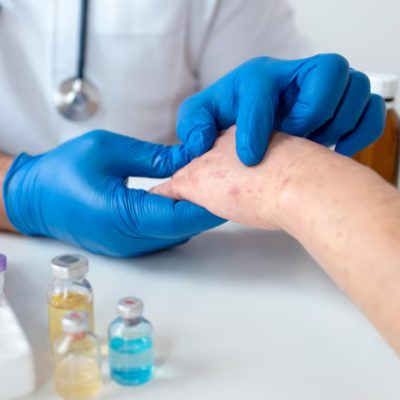Allergy Testing
Allergies are common and can significantly impact one’s quality of life. They occur when the immune system reacts to a foreign substance, such as pollen, food, dust or pet dander. Allergy testing is a critical tool in diagnosing and managing allergic conditions by identifying specific allergens responsible for triggering symptoms.

What is Allergy Testing?
Allergy testing is a diagnostic procedure used to determine whether your body has an allergic response to a known substance. It helps pinpoint specific allergens that trigger symptoms, allowing for tailored management and treatment. Common allergens tested include pollen, dust mites, mold, pet dander, foods and insect stings. Allergy testing is essential for individuals who experience unexplained symptoms such as rashes, hives, sneezing, runny nose or asthma.
Method & Treatment for Allergy Testing
There are several types of allergy tests, each designed to identify specific allergens. The most common methods include:
Skin Prick Test (SPT)
- Procedure: A small amount of the suspected allergen is introduced into the skin, usually on the forearm or back, using a tiny needle or lancet. If the person is allergic, a small raised bump (wheal) will appear at the test site within 15-20 minutes.
- Treatment Plan: The test is quick, minimally invasive, and can test multiple allergens simultaneously. It’s suitable for diagnosing environmental allergens, food allergies and insect venom allergies.
Intradermal Skin Test
- Procedure: A small amount of allergen solution is injected just under the skin. This test is more sensitive than the skin prick test and is often used when the skin prick test is negative but allergy is still suspected.
- Treatment Plan: This method is commonly used for testing allergies to insect venom or penicillin.
Patch Test
- Procedure: A patch test is used to identify contact allergens, such as those causing eczema. Patches containing allergens are applied to the skin, typically on the back and left in place for 48 hours. The skin is then examined for reactions at 48 and 72 hours.
- Treatment Plan: This test is ideal for identifying allergic contact dermatitis caused by substances like metals, fragrances and preservatives.
Blood Test (Specific IgE Test or RAST)
- Procedure: A blood sample is drawn to measure the level of specific IgE antibodies in response to particular allergens. This test is beneficial for individuals who cannot undergo skin testing due to severe eczema or those on medications that interfere with skin tests.
- Treatment Plan: Blood tests are less sensitive than skin tests, but provide useful information on allergic sensitization.
Applications of Allergy Testing
Allergy testing can be applied to a variety of conditions, including:
Respiratory Allergies
Asthma, allergic rhinitis (hay fever) and sinusitis.
Skin Allergies
Eczema, urticaria (hives) and contact dermatitis.
Food Allergies
Reactions to foods such as nuts, shellfish, eggs and milk.
Insect Allergies
Reactions to stings from bees, wasps or other insects.
Drug Allergies
Allergies to medications like antibiotics, anesthesia or NSAIDs.
Precautions and Risks of Allergy Testing
- A thorough medical history is taken to identify any contraindications or conditions that may affect testing.
- Some medications, such as antihistamines, can interfere with test results. Patients may need to stop these medications for a specified period before testing.
- Patients with severe asthma or a history of anaphylaxis are closely monitored during testing.
- Redness, itching or swelling at the test site are common and usually resolve quickly.
- Although rare, some patients may experience more widespread symptoms, such as sneezing, itching or mild wheezing.
- Anaphylaxis is a rare but serious risk. Testing should always be done in a setting equipped to manage severe allergic reactions.
Post-Procedure Signs to Look Out For
Localized Reactions: Mild swelling, redness or itching at the test site is normal and typically subsides within a few hours.
Delayed Reactions: Some patients may experience delayed reactions, particularly with patch testing, which can manifest as localized redness or rash.
Severe Symptoms: Immediate medical attention is required if signs of anaphylaxis occur, such as difficulty breathing, swelling of the face or throat or rapid heart rate.
Complementary Measures for Better Outcomes
Allergy testing can be paired with certain cosmetic or dermatologic procedures to manage allergic skin conditions more effectively:
Skin Barrier Repair Treatments
For patients with eczema or contact dermatitis, barrier repair treatments such as moisturizing therapies or barrier creams can complement allergy management.
Ultraviolet B (UVB) Phototherapy
UVB phototherapy can help manage chronic eczema or psoriasis, which may be exacerbated by allergies.
Anti-Inflammatory Treatments
Topical or systemic anti-inflammatory treatments can help manage skin conditions that worsen due to allergic triggers.
Dietary Adjustments
For food allergies, diet modification guided by the results of allergy testing can improve overall skin health and reduce flare-ups.
Lifestyle Changes
Once triggering factors such as perfumes, pollen or dust are identified and confirmed, they must be avoided to prevent allergic reactions from breaking out.
